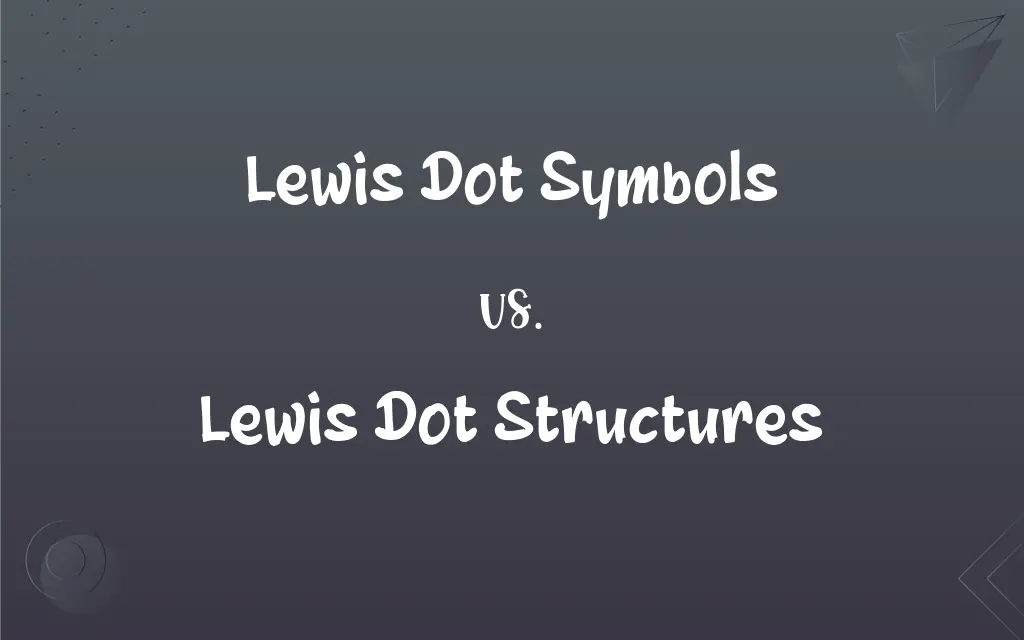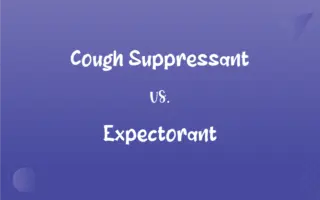Lewis Dot Symbols vs. Lewis Dot Structures: What's the Difference?
Edited by Aimie Carlson || By Janet White || Published on March 31, 2024
Lewis dot symbols represent the valence electrons of an atom, while Lewis dot structures show the bonding between atoms in a molecule.

Key Differences
Lewis dot symbols and Lewis dot structures are fundamental concepts in chemistry, each serving a distinct purpose in understanding atomic and molecular structures. Lewis dot symbols focus on individual atoms, depicting the valence electrons as dots around the element's symbol, which helps in predicting bonding behavior and chemical reactivity. Lewis dot structures, on the other hand, extend this concept to molecules and polyatomic ions, illustrating how atoms bond together and distribute their valence electrons in the form of shared or lone pairs.
The simplicity of Lewis dot symbols makes them a powerful tool for quickly assessing an element's potential for forming bonds. By representing valence electrons as dots, these symbols indicate an atom's capacity to gain, lose, or share electrons. In contrast, Lewis dot structures provide a more comprehensive picture, showing not just the potential for bond formation but the actual bonds within a molecule, including double and triple bonds, and the arrangement of lone pairs, which are crucial for understanding molecular geometry and polarity.
When drawing Lewis dot symbols, the primary focus is on the outermost electrons of an atom, which are most involved in chemical bonding. This representation is particularly useful in the context of the octet rule, which predicts stability in atoms when they have eight electrons in their valence shell. Lewis dot structures take this a step further by applying the octet rule to molecules, demonstrating how atoms share electrons to achieve stability, and highlighting exceptions to the octet rule in certain molecules.
The application of Lewis dot symbols and structures varies significantly. Lewis dot symbols are often used in the early stages of learning chemistry to build foundational knowledge of atomic behavior and periodic trends. Lewis dot structures, however, are utilized in more advanced discussions of chemical bonding, molecular geometry, and reaction mechanisms, offering insights into the spatial arrangement of atoms and the distribution of electrons in molecules.
Understanding the difference between Lewis dot symbols and structures is crucial for students and professionals in chemistry. While Lewis dot symbols serve as the building blocks, providing a snapshot of an atom's valence electrons, Lewis dot structures build on this by illustrating the complex interactions between atoms within molecules, making them indispensable tools in the visualization and prediction of chemical behavior.
ADVERTISEMENT
Comparison Chart
Representation
Individual atoms
Molecules or polyatomic ions
Focus
Valence electrons of atoms
Bonding and arrangement of electrons in molecules
Visual Information
Dots around atomic symbols
Dots and lines representing bonds between atoms
Purpose
Predict atomic bonding behavior
Illustrate molecular structure and bonding
Complexity
Simple, focuses on single atoms
More complex, shows interactions between multiple atoms
ADVERTISEMENT
Lewis Dot Symbols and Lewis Dot Structures Definitions
Lewis Dot Symbols
Lewis dot symbols show an atom's valence electrons.
The Lewis dot symbol for Sodium (Na) has one dot representing its single valence electron.
Lewis Dot Structures
Lewis dot structures represent molecules' bonding.
The Lewis dot structure for water (H2O) shows two O-H bonds with two pairs of lone electrons on oxygen.
Lewis Dot Symbols
Lewis dot symbols can indicate an element's reactivity.
Chlorine's Lewis dot symbol, with seven dots, suggests it needs one more electron to achieve an octet.
Lewis Dot Structures
Lewis dot structures illustrate lone pairs of electrons.
Ammonia's (NH3) Lewis dot structure includes a lone pair of electrons on the nitrogen atom.
Lewis Dot Symbols
Lewis dot symbols help in understanding chemical bonding.
The Lewis dot symbol for Hydrogen (H) with one dot shows its ability to form one bond.
Lewis Dot Structures
Lewis dot structures aid in understanding molecule polarity.
The Lewis dot structure for HCl shows a polar bond due to unequal electron sharing.
Lewis Dot Symbols
Lewis dot symbols are foundational in chemistry education.
Students often learn to draw Lewis dot symbols for elements like Carbon (C) with four dots.
Lewis Dot Structures
Lewis dot structures can depict double and triple bonds.
In the Lewis dot structure for CO2, two double bonds connect carbon and oxygen atoms.
Lewis Dot Symbols
Lewis dot symbols are centered around the chemical symbol.
In the Lewis dot symbol for Oxygen (O), six dots surround the 'O' symbol.
Lewis Dot Structures
Lewis dot structures are used to predict molecular shapes.
The Lewis dot structure for methane (CH4) suggests a tetrahedral molecular geometry.
FAQs
What are Lewis dot symbols?
Representations of the valence electrons of an atom using dots.
What do Lewis dot structures depict?
The bonding between atoms in a molecule and lone pairs of electrons.
Can Lewis dot symbols be used for all elements?
They are most useful for main group elements that follow the octet rule.
Why are Lewis dot structures important in chemistry?
They help visualize molecular structure, bonding, and electron distribution.
Can Lewis dot symbols predict an element's bonding behavior?
Yes, by showing the valence electrons, they indicate bonding potential.
How do Lewis dot symbols aid in understanding periodic trends?
They show trends in valence electrons, affecting reactivity and bonding.
How do Lewis dot symbols differ from Lewis dot structures?
Symbols focus on individual atoms; structures show entire molecules.
How do you determine the number of dots in a Lewis dot symbol?
The number of dots equals the number of valence electrons in the atom.
Are Lewis dot symbols used for transition metals?
Less frequently, as transition metals have complex electron configurations.
How are double and triple bonds represented in Lewis dot structures?
By two or three lines between atoms, respectively.
Are there limitations to Lewis dot structures?
Yes, they may not accurately depict complex bonding in some molecules.
Can Lewis dot structures predict molecular polarity?
Yes, by showing asymmetric distribution of electrons.
Do Lewis dot structures represent molecular geometry?
Indirectly, by showing spatial arrangement of bonds and lone pairs.
Do Lewis dot structures always follow the octet rule?
Mostly, but there are exceptions, especially with elements beyond the second period.
How are ions represented in Lewis dot symbols and structures?
By adding or removing dots for electrons and sometimes using brackets with a charge.
How does molecular size affect Lewis dot structures?
Larger molecules may have more complex structures with multiple bonding patterns.
Can Lewis dot symbols show an atom's ability to gain or lose electrons?
Yes, by the number and arrangement of dots.
What does a lone pair in a Lewis dot structure indicate?
Non-bonding valence electrons localized on an atom.
What's the significance of drawing Lewis dot structures for reactions?
They help visualize reactants' and products' electron arrangements.
How do you represent resonance structures in Lewis dot structures?
By drawing multiple structures to represent electron delocalization.
About Author
Written by
Janet WhiteJanet White has been an esteemed writer and blogger for Difference Wiki. Holding a Master's degree in Science and Medical Journalism from the prestigious Boston University, she has consistently demonstrated her expertise and passion for her field. When she's not immersed in her work, Janet relishes her time exercising, delving into a good book, and cherishing moments with friends and family.
Edited by
Aimie CarlsonAimie Carlson, holding a master's degree in English literature, is a fervent English language enthusiast. She lends her writing talents to Difference Wiki, a prominent website that specializes in comparisons, offering readers insightful analyses that both captivate and inform.







































































